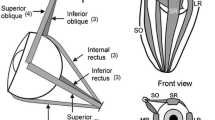Summary
Feedback mechanisms exist in all the periferal sense organs including the eye, which acts as a highly efficient position control servo system. Histological studies so far have not revealed the precise circuitry of the eye movement control system but some information about it can be obtained by a study of the sources of feedback. Existing theories have considered three types of feedback originating in the oculomotor tract, in the proprioceptive fibres of the extrinsic eye muscles and from retinal image displacement. In the present experiments an optical arrangement has been used to vary or eliminate the amount of information available from retinal image motion, and the response of the eye to simple harmonic displacement of a target has been recorded. The response curves of gain (eyeball movement divided by target motion) against frequency indicate that the system is lion linear when the image falls in the retinal region which is insensitive to position. Outside this area, retinal image position is used as negative feedback but the information from the oculomotor tract must be regenerative. There is also evidence for feedback proportional to the first derivative of eyeball position and this function is ascribed to the proprioceptive signals; this form of feedback appears to saturate for large amplitude movements, thus avoiding heavy damping of the flick movements.
A schematic eye movement control system having the same characteristics as the eye is proposed. The transfer function of this system indicates that it should be unstable if the sign of the retinal image feedback loop is reversed. Experiments with this form of feedback show that steady fixation is impossible and the eye performs a pendular nystagmus.
Similar content being viewed by others
References
Barlow, H. B.: Eye movements during fixation. J. Physiol. (Lond.) 116, 290 (1952).
Bode, H.W.: Network analysis and feedback amplifier design. Published, Van Nostrand 1945.
Cooper, S., P. D. Daniel and D. Whitteridge: Afferent impulses in the oculomotor nerve from the extrinsic eye muscles. J. Physiol. (Lond.) 113, 463 (1953).
Cornsweet, T. N.: Determination of the stimuli for involuntary drifts and saccadic eye movements. J. opt. Soc. Amer. 46, 987 (1956).
Ditchburn, R. W.: Eye-movements in relation to retinal action. Optica Acta 1, 171 (1955).
Ditchburn, R. W., and B. L. Ginsborg: Vision with a stabilised retinal image. Nature (Lond.) 170, 36 (1952).
Doesschate, J. ten: A new form of physiological nystagmus. Opthalmologica (Basel) 127, 65 (1954).
Gaarder, K.: Relating a component of physiological nystagmus to visual display. Science 132, 471 (1960).
Glezer, V. D.: The characteristics of the eye as a scanning system. Physiol. J. USSR. 45, 211 (1959).
Hedlun, J. M., and C. T. White: Nystagmus induced by visual feedback. J. opt. Soc. Amer. 49, 729 (1959).
Kornmüller, A. E.: J. Psychol. Neurol. (Lpz.) 41, 354 (1930).
Lettvin, J. Y.: Quarterly progress reports. Res. Labs. Electronics, Mass. Inst. Tech., July 1960.
Nachmias, J.: Meridional variations in visual acuity and eye movements during fixation. J. opt. Soc. Amer. 50, 569 (1960).
Riggs, L. A., F. Ratliff, T. N. Cornsweet and J. C. Cornsweet: The disappearance of steadily fixated visual test objects. J. opt. Soc. Amer. 43, 495 (1953).
Riggs, L. A., and S. U. Tulunay: Visual effects of varying the extent of compensation for eye movements. J. opt. Soc. Amer. 49, 741 (1959).
Sünderhauf, A.: Untersuchungen über die Regelung der Augenbewegungen. Klin. Mbl. Augenheilk. 136, 837 (1960).
Trincker, D. v., J. Seiber u. J. Bartual: Schwingungsanalyse der vestibulär, optokinetisch und durch elektrische Reizung ausgelösten Augenbewegungen beim Menschen. Kybernetik 1, 21 (1961).
Westheimer, G.: Eye movement responses to a horizontally moving visual stimulus. A.M.A. Arch. Opthal. 52, 932 (1954).
Whitteridge, D.: Central control of eye movements. Handbook of Physiology-Neurophysiology, vol. 11. chap. XLII, Amer. Physiological Soc. Washington 1960.
Author information
Authors and Affiliations
Rights and permissions
About this article
Cite this article
Fender, D.H., Nye, P.W. An investigation of the mechanisms of eye movement control. Kybernetik 1, 81–88 (1961). https://doi.org/10.1007/BF00288819
Issue Date:
DOI: https://doi.org/10.1007/BF00288819




